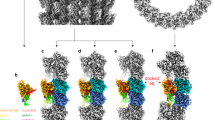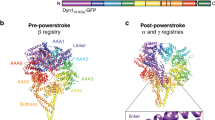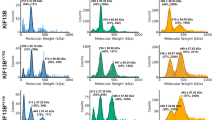Abstract
Molecular motors require ATP to move along microtubules or actin filaments. To understand how molecular motors function, it is crucial to know how binding of the motor to its filamentous track stimulates the hydrolysis of ATP by the motor, enabling it to move along the filament. A mechanism for the enhanced ATP hydrolysis has not been elucidated, but it is generally accepted that conformational changes in the motor proteins1,2,3 occur when they bind to microtubules or actin filaments, facilitating the release of ADP. Here we report that a mutation in the motor domain of the microtubule motor proteins Kar3 and Ncd uncouples nucleotide- and microtubule-binding by the proteins, preventing activation of the motor ATPase by microtubules. Unlike the wild-type motors, the mutants bind tightly to both ADP and microtubules, indicating that interactions between the nucleotide- and microtubule-binding sites are blocked. The region of the motor that includes the mutated amino acid could transmit or undergo a conformational change required to convert the motor ATPase into a microtubule-stimulated state.
This is a preview of subscription content, access via your institution
Access options
Subscribe to this journal
Receive 51 print issues and online access
$199.00 per year
only $3.90 per issue
Buy this article
- Purchase on Springer Link
- Instant access to full article PDF
Prices may be subject to local taxes which are calculated during checkout




Similar content being viewed by others
References
Hirose, K., Lockhart, A., Cross, R. A. & Amos, L. A. Nucleotide-dependent angular change in kinesin motor domain bound to tubulin. Nature 376, 277–279 (1995).
Whittaker, M. et al. A35-Å movement of smooth muscle myosin on ADP release. Nature 378, 748–751 (1995).
Dominguez, R., Freyzon, Y., Trybus, K. M. & Cohen, C. Crystal structure of a vertebrate smooth muscle myosin motor domain and its complex with the essential light chain: visualization of the pre-power stroke state. Cell 94, 559–571 (1998).
Meluh, P. B. & Rose, M. D. KAR3, a kinesin-related gene required for yeast nuclear fusion. Cell 60, 1029–1041 (1990).
Bascom-Slack, C. A. & Dawson, D. S. The yeast motor protein, Kar3p, is essential for meiosis I. J. Cell Biol. 139, 459–467 (1997).
Saunders, W., Lengyel, V. & Hoyt, M. A. Mitotic spindle function in Saccharomyces cerevisiae requires a balance between different types of kinesin-related motors. Mol. Biol. Cell 8, 1025–1033 (1997).
Saunders, W. S. & Hoyt, M. A. Kinesin-related proteins required for structural integrity of the mitotic spindle. Cell 70, 451–458 (1992).
Hoyt, M. A., He, L., Totis, L. & Saunders, W. S. Loss of function of Saccharomyces cerevisiae kinesin-related CIN8 and KIP1 is suppressed by KAR3 motor domain mutations. Genetics 135, 35–44 (1993).
Song, H. & Endow, S. A. Rapid purification of microtubule motor domain proteins expressed in bacteria. BioTechniques 22, 82–85 (1997).
Huang, T.-G. & Hackney, D. D. Drosophila kinesin minimal motor domain expressed in Escherichia coli. J. Biol. Chem. 269, 16493–16501 (1994).
Bloom, G. S. & Endow, S. A. Motor proteins 1: kinesins. Protein Prof. 2, 1109–1171 (1995).
Chandra, R., Salmon, E. D., Erickson, H. P., Lockhart, A. & Endow, S. A. Structural and functional domains of the Drosophila ncd microtubule motor protein. J. Biol. Chem. 268, 9005–9013 (1993).
Endow, S. A. et al. Yeast Kar3 is a minus-end microtubule motor protein that destabilizes microtubules preferentialy at the minus ends. EMBO J. 13, 2708–2713 (1994).
Song, H., Golovkin, M., Reddy, A. S. N. & Endow, S. A. In vitro motility of AtKCBP, a calmodulin-binding kinesin protein of Arabidopsis. Proc. Natl Acad. Sci. USA 94, 322–327 (1997).
Gulick, A. M., Song, H., Endow, S. A. & Rayment, I. X-ray crystal structure of the yeast Kar3 motor domain complexed with Mg·ADP to 2.3 Å resolution. Biochemistry 37, 1769–1776 (1998).
Sablin, E. P., Kull, F. J., Cooke, R., Vale, R. D. & Fletterick, R. J. Crystal structure of the motor domain of the kinesin-related motor ncd. Nature 380, 555–559 (1996).
Woehlke, G. et al. Microtubule interaction site of the kinesin motor. Cell 90, 207–216 (1997).
Ruppel, K. M. & Spudich, J. A. Structure-function studies of the myosin motor domain: importance of the 50-kDa cleft. Mol. Biol. Cell 7, 1123–1136 (1996).
Kull, F. J., Sablin, E. P., Lau, R., Fletterick, R. J. & Vale, R. D. Crystal structure of the kinesin motor domain reveals a structural similarity to myosin. Nature 380, 550–555 (1996).
Studier, F. W., Rosenberg, A. H., Dunn, J. J. & Dubendorff, J. W. Use of T7 RNA polymerase to direct expression of cloned genes. Methods Enzymol. 185, 60–89 (1990).
Ho, S. N., Hunt, H. D., Horton, R. M., Pullen, J. K. & Pease, L. R. Site-directed mutagenesis by overlap extension using the polymerase chain reaction. Gene 77, 51–59 (1989).
Song, H. & Endow, S. A. Binding sites on microtubules of kinesin motors of the same or opposite polarity. Biochemistry 35, 11203–11209 (1996).
Moore, J. D., Song, H. & Endow, S. A. Apoint mutation in the microtubule-binding region of the Ncd motor protein reduces motor velocity. EMBO J. 15, 3306–3314 (1996).
Acknowledgements
We thank A. Hoyt for kar3-898, C. Fierke and K. Hightower for help with fluorometry and the use of a fluorometer, S. Rosenfeld for mant-ATP and A. Gulick for comments on the manuscript. This work was supported by the NIH.
Author information
Authors and Affiliations
Corresponding author
Rights and permissions
About this article
Cite this article
Song, H., Endow, S. Decoupling of nucleotide- and microtubule-binding sites in a kinesin mutant. Nature 396, 587–590 (1998). https://doi.org/10.1038/25153
Received:
Accepted:
Issue Date:
DOI: https://doi.org/10.1038/25153
This article is cited by
-
Structural basis of small molecule ATPase inhibition of a human mitotic kinesin motor protein
Scientific Reports (2017)
-
Anchor Effect of Interactions Between Kinesin’s Nucleotide-Binding Pocket and Microtubule
Cellular and Molecular Bioengineering (2017)
-
A CEP215–HSET complex links centrosomes with spindle poles and drives centrosome clustering in cancer
Nature Communications (2016)
-
Kinesin Motor Enzymology: Chemistry, Structure, and Physics of Nanoscale Molecular Machines
Biophysical Reviews (2015)
-
A kinesin motor in a force-producing conformation
BMC Structural Biology (2010)
Comments
By submitting a comment you agree to abide by our Terms and Community Guidelines. If you find something abusive or that does not comply with our terms or guidelines please flag it as inappropriate.



